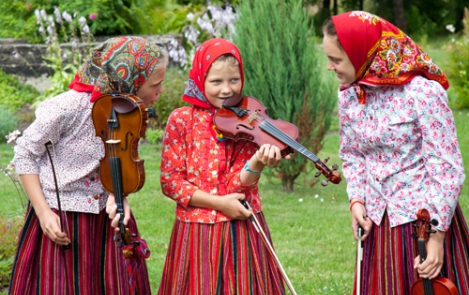-
Reset
+


‘The wonder of Estonia’ - Kodukiri magazine, November 2012
01.11.2012
Kihnu is a special place. No one who's been there, even if only the once, would claim otherwise. So much about it is unusual. How often, for example, are individual cultural fragments of a nation and their ways of life granted world heritage status by UNESCO? What is it that makes Kihnu the only municipality in Estonia posting positive population growth without any kind of resettlement from the mainland? (The community on the island has been growing, slowly but surely, for the better part of a hundred years.) What brings its people together as soon as the women of Kihnu start singing? And what drives Estonia's – and indeed some of the world's – best folk musicians to undertake the choppy voyage to the island the moment they hear its call?
The phenomenon of Kihnu is something that movie makers, musicians, folklorists and dance experts have been trying to put into words for a long time. When they all sit down and attempt to articulate from their own perspectives what lends the island its particular charm, the mosaic starts to come together. I happened to hear one such conversation, which focussed on the traditional Kihnu dance. It has little in common with what we see (or indeed experience) at national dance festivals – or does it? Singing and making music together, just like dancing together, creates a collective rhythm, a pulsation, which in turn fosters energy that is passed on from person to person, including the audience. And if you let yourself be carried along by that feeling, it can last forever. You can spin endlessly around and around, or slow dance to fast-paced music. It's all about economical movement: how we hold ourselves and one another; how we sense our axis and centre of balance. Economical movement draws its strength from the ground, making use of gravity in its most direct meaning instead of constantly attempting to jump up and down and escape its pull. It's a form of movement that is flat-footed and uniform, and always transpires in circles. And it's a form of movement that you'll only see or experience for yourself at dance festivals on Kihnu – it's no longer found anywhere else in Estonia. Viewed from afar it barely even registers as movement per se; it comes across as an expression of serenity and harmony. Knowing all this means that even the uninitiated can tell the locals from the visitors at festivities held on the island.
Those who study dances say that as communities collapse and are swept away by the wave of globalisation their shared movement, that pulsation, is being replaced by something called a polyrhythm. It's expressed in rhythmic jumping, and against a backdrop of harmonious movement these jumpers have an effect rather like Brown's molecules. If you compare two forms of movement – one economical and the other polyrhythmic – which one will outlast the other? It's a rhetorical question: at weddings on Kihnu they dance and play their instruments for three days straight, regardless of age. Those who jump about, on the other hand, tend to wear themselves out within a few hours.
Folk music and folk dancing today have become very much stage-centric – audiences enjoy them as separate art forms. In the real world, however, where they originate, they've always come as a package. For instance, in Poland, bucking the trend, people have started to rediscover the village ways of life that have been preserved in the country. They're marvelling at musicians who can play for three days straight, and at the villagers, old and new, who move to their rhythm. Those dances continue for days on end! The tradition of village festivities is steadily re-emerging, drawing people of all ages – anyone who can dance – back from the city to the country. And although the songs the Poles sing and the dances they dance are different from ours, they're soon able to start moving like the islanders from Kihnu. For us, on the other hand – not only ordinary folk, but even professional folk dancers – it's a hard ask. And while everything at parties on Kihnu, whatever the music, basically comes back to three dances (the Rheinländer, the Waltz or the Polka), Polish villagers can dance to their rhythm even to DJ Gomez.
It's something of a wonder, really, that we have this place and this fragment of our nation where almost everyone plays an instrument, dances their own dances, sings their own songs, speaks their own dialect, wears traditional clothes and subsists on local produce. The fact that they can move to a collective rhythm gives them an energy that those on the outside never truly experience. It's the power of their community. It's as though little Kihnu is living the Estonian dream. It's inspired and enchanted me. Thank you for giving me that!



